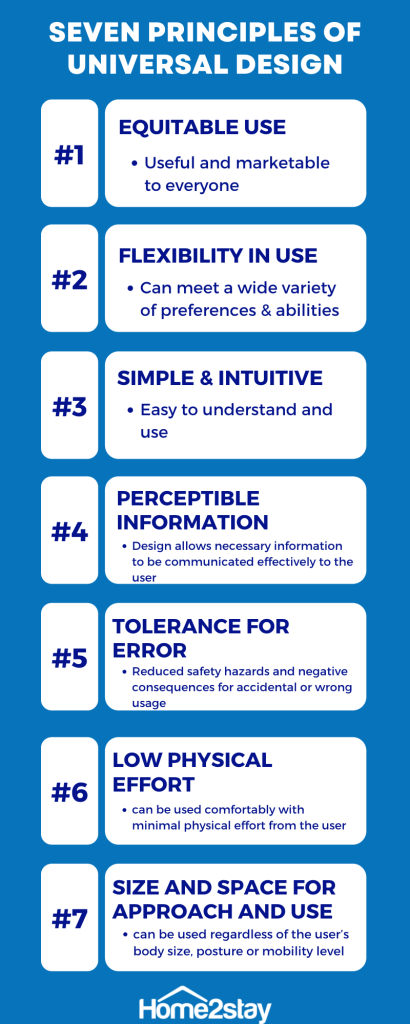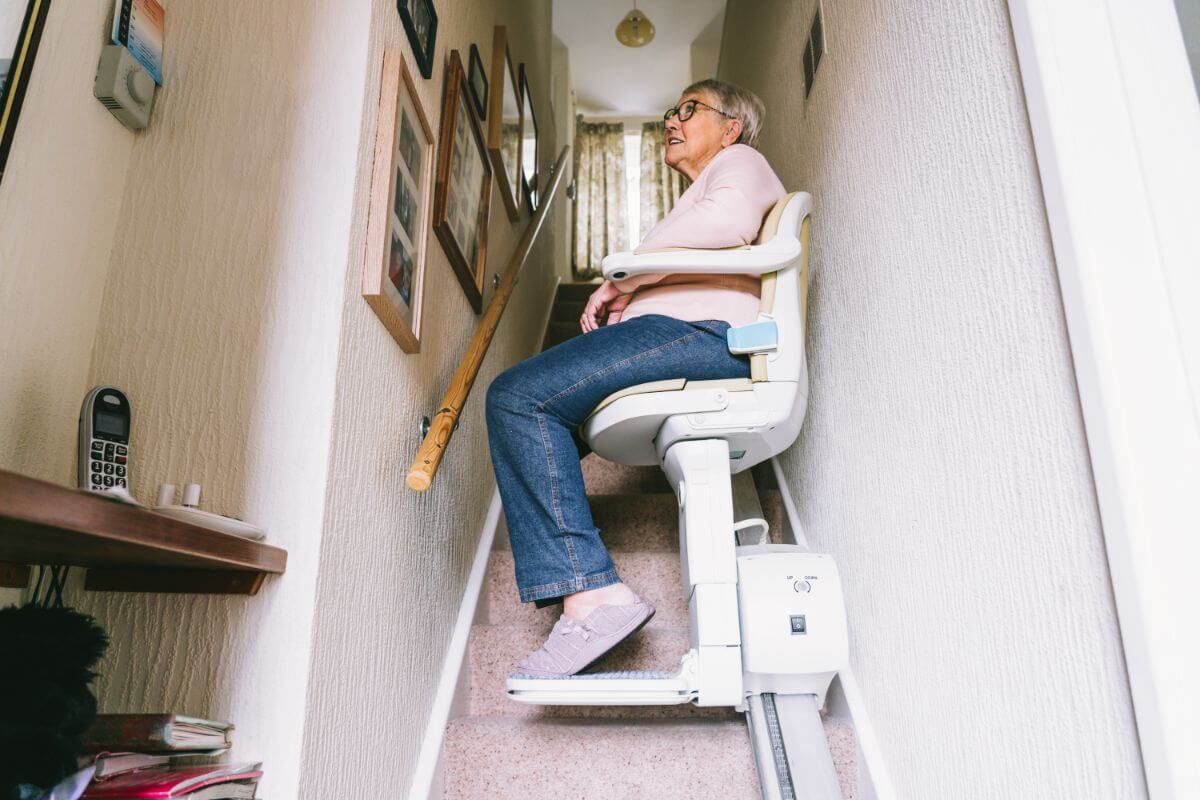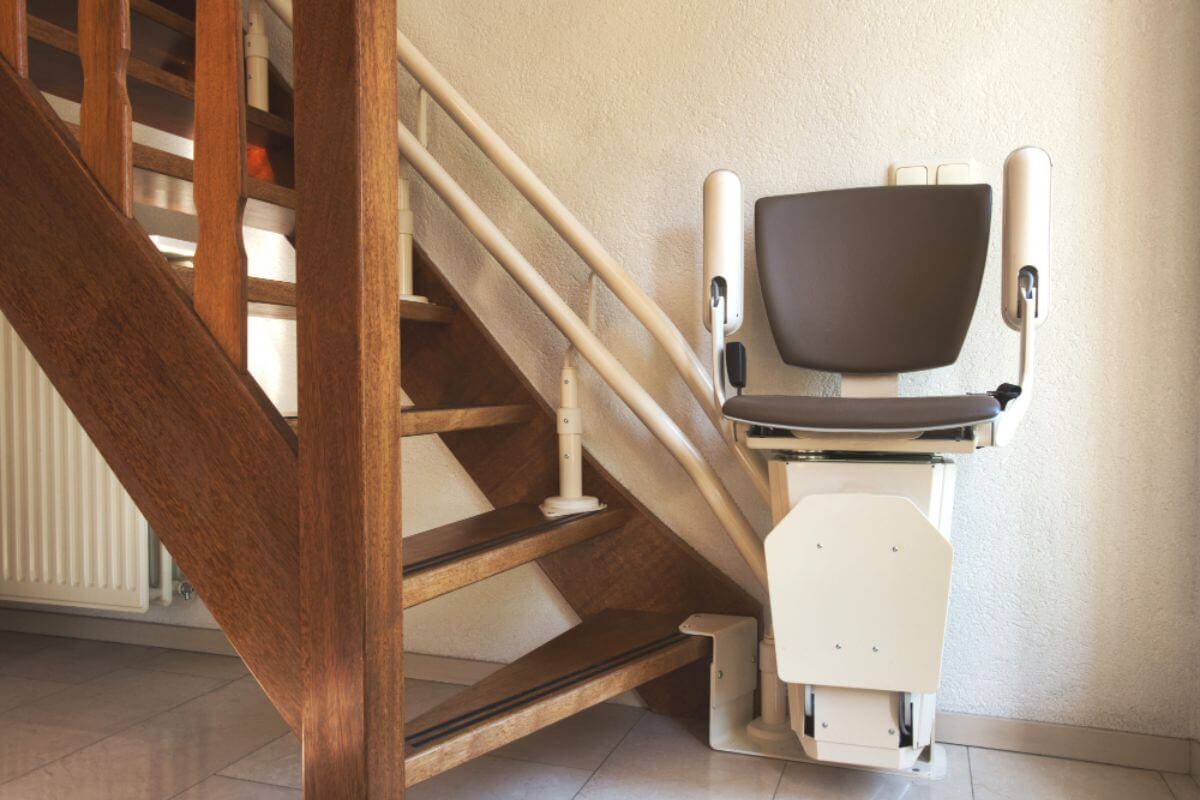6 Myths & 6 Truths About Universal Design

Universal design in the physical environment is the configuration and arrangement of the space’s design so that it can meet the needs of all who wish to use it, regardless of age, size and abilities.
Who can benefit from physical surroundings which are accessible, convenient and easy to use?
Everyone.
Universal design is not just for a minority of our population- it is fundamental to good and useful design.
Take this example of placing an access ramp on your space’s entry / exit points:


The impression that universal design only benefits persons of certain age groups or abilities is just one of the myths around it.
Let’s set the record straight for 6 misconceptions about universal and accessible design:
1. Myth: Universal design is only for people with disabilities.
Truth: Universal design does not target any particular group of people.
It is not designed for people with disabilities only- simply, it’s just better design. The majority of the population are not even aware that they are using universal design features on a daily basis.
These include safer and more convenient stairways and handrails, automatic doors, touchless faucets, and sloped ramps for moving strollers or shopping carts.
Everyone benefits when venues adopt universal design:
- Children of various height and sizes can be safe and comfortable in the space
- Senior citizens may use washrooms independently while maintaining their dignity
- Individuals can safely and conveniently grow old in their homes.
Simply put, universal design means going with the most inclusive design possible. There is no such thing that when a feature benefits a certain group of people, it degrades others’ experience or makes it inconvenient for others.
Universal design liberates everyone. It is not based on typical design specifications aimed at healthy males between the ages of 18 and 55. When a place works for everyone, such as a park with an even surface and accessible playground equipment, individuals of all ages and physical abilities can use the facilities- that is how empowering universal design is.
2. Myth: A home with universal design looks unattractive, institutional, and creates a stigma that it was built for someone with a disability.
Truth: The expertise and experience of the designers and product providers determine the beauty of a universally designed home.
Universal design features and products increase the aesthetic of a home while also making it practical for persons with disabilities and extra convenient for people without disabilities.
There are many lovely accessibility products that make use of universal design but don’t appear institutional, such as durable and rust-proof railings and safety poles, different models of walk-in bathtubs, handcrafted rails for your stairways and “hidden” or multifunction grab bars that are available in the marketplace.
Universal design does not rely solely on functionality, but recognizes that a product’s look might influence its usability.
The aesthetic usability effect states that individuals prefer to use designs that appear to be simple and user-friendly.
Myth: Universal design does not reflect my needs because disability affects other individuals or families only.
Truth: Prepare and prevent, rather than repair and repent. Universal design makes everyone’s life easier, healthier and friendlier not just for now, but also in the long run.
It may not cross your mind to consider how well your home or an establishment treats you if you’re young, fit, and healthy. However, as you grow older, you realize how some previously simple activities such as climbing up and down the stairs, reaching for objects placed on high shelves, twisting your body to get things, and turning standard round door knobs eventually becomes more challenging and difficult to accomplish.
Poor ergonomics are harming your body little-by-little, and you will pay the price later on in life. You only have one body- why not treat your body as kindly as possible, even when you are still strong and healthy?
Applying universal design principles in your space as early as possible will ensure that you minimize aches, pains and disabilities when you age.
Also, keep in mind that your and your loved ones’ situation may change any time- There is no telling when any one of us could be in an accident, have a stroke, lose our sight or hearing. Universal design anticipates consumers’ needs now and in the future.
It’s vital to alter our perceptions about impairment. People with disabilities are the world’s largest minority group. And the only group that anyone can be a part of- anytime and without warning.
Myth: Universal design is too costly.
Truth: You can choose from a variety of affordable, value-for-money accessibility products that incorporate universal design.
In general, appliances with universal design elements are not more expensive. In fact, by adapting design elements and products that encourage universal design, your home will become more valuable because it will retain its usefulness for a longer period of time.
In the long run, universal design saves money since “unmet and unforeseen” customer requirements can be addressed early on rather than being added later or requiring you to buy new equipment, usually at significant expense.
Myth: Universal design necessitates more space.
Truth: Multiple uses and/or overlap of clear floor spaces allows more clear floor spaces in relatively tiny rooms.
Square footage can also be saved by designing an open floor plan with fewer passageways. There will be much greater accessibility, comfort, and convenience if appropriate space is provided in the kitchen and restrooms.
A universal design home does not require greater square footage, but rather enough space for someone with a disability, like a person in a wheelchair, to go about the home.
A practical example of how this can be accomplished without additional space is to raise or lower the height of counters to suit users of different heights- raised surfaces also allow extra leg room for wheelchair users to make a 360-degree turn. Sliding doors can provide larger door openings without the need to widen the doorway.
Something as simple as pushing the furniture against the wall can provide more leg room in a tiny space.
In the bathroom, implementing universal design without the need for bigger space can be done by using a zero-entry or barrier-free roll-in shower, roll-under sinks, and a tilting mirror that can accommodate both standing and sitting users.
Myth: Building codes already address accessibility.
Truth: Universal design considers how people interact with a facility as a whole, from entrance to wayfinding to emergency evacuation. This is true, meaningful accessibility- respecting the whole range of abilities.
This is not the same as minimum coding requirements.
The National Building Code of Canada 2015 provides heavy focus on physical mobility concerns, while efforts or guidelines related to addressing impediments and obstacles for individuals with sensory or intellectual disabilities are minimal.
Aging-in-place solutions, such as a duplex power box for charging mobility equipment and personal assistance devices like hearing aids or scooters, can be included in the universal design of homes. It could feature reinforced ceilings and wall backings to allow elevators, grab bars, and exercise pulleys to be installed.
To accommodate all individuals with sensory or intellectual disabilities, applying universal design principles can mean control buttons (such as in lifts or other mechanical equipment) that are labeled with text and symbols, making them simpler and more intuitive to understand.
Parking spaces can be labeled not only with numbers, but also color-coded to make it easier to identify and remember. Display materials, like in a museum or shop, can have written captions and voice-over descriptions so patrons can choose to read or listen to a description of the contents.


The Center for Universal Design at North Carolina State University devised seven universal design principles to guide the creation of any product, service, or location.
- Equitable use– people of various capacities will find the design useful and marketable.
A web page built to be accessible to everyone, including those with visual impairments and those who use text-to-speech technology, is an illustration of this approach.
- Flexibility in use– individual preferences and abilities are accommodated by the design.
A captioned video, for example, gives viewers the option of listening or reading to comprehend the material. This not only allows people with hearing problems access, but it also allows others who prefer not to listen to music or who learn better by reading.
- Simple and intuitive– the design is simple to use regardless of the user’s experience, expertise, language skills, or present concentration level.
A remote control with buttons labeled using basic language and symbols that are easy to understand is an example of this idea.
- Perceptible information– the design efficiently transmits important information to the user regardless of ambient conditions or the user’s sensory capacities .
This can be done by using different modes (pictorial, verbal, tactile) of redundant presentation of essential information.
- Tolerance for error– the design reduces dangers and the negative repercussions of unintentional or accidental behaviors.
For example, a hallway is clear of protruding objects at a height where a cane-wielding person with a visual impairment would miss them.
- Low physical effort– allows for efficient, comfortable, and fatigue-free operation.
A sink faucet that automatically activates when a person places their hands underneath it is an example of this principle in action.
- Size and space for approach and use– adequate size and space is allowed for approach, reach, and manipulation regardless of physical features such as size or mobility,
For example, a flexible work area that provides enough space for people who are left- or right-handed, as well as those who need to work standing or seated.

While the principles of universal design may seem daunting at first sight, they are actually very practical and simple- focused on making the environment, products and services accessible and easy to use for everyone. Applying these principles in your home will allow you to have room for flexibility and give you the best chance to be comfortable in the home you love, regardless of age or abilities.
How do you prepare yourself for old age? It’s time to look beyond the financials and check your physical environment too. When you build your dream home at 28, think ahead to when you are 68 years old- Will your home remain comfortable and friendly to your needs, even in your old age?
With universal design, you and your family can enjoy safety, accessibility and comfort throughout the whole span of your lives.
If you are in the British Columbia area, universal design experts from our Home2stay team can help you apply these principles to your home or business establishment. Partner with us in our big mission of creating a more accessible and inclusive community for everyone!





Leave a Comment
We'd Love to Hear Your Thoughts Got something to say? We're all ears! Leave your comments below and let us know what you think. Your feedback helps us improve and serve you better. Can't wait to hear from you!